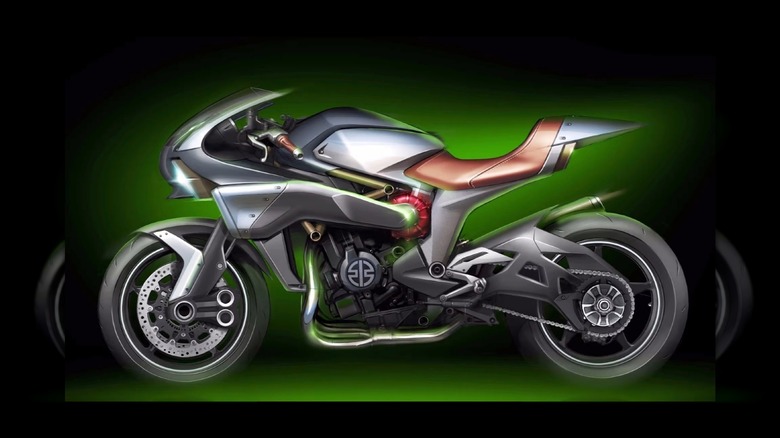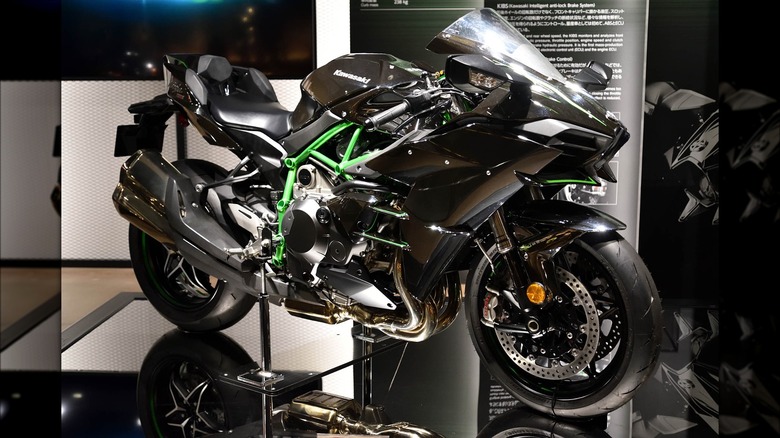The SC-01 Spirit Charger & The Concept Engine That Supercharged Kawasaki
At the 2016 Tokyo Motor Show, Kawasaki revealed a supercharger concept that claimed to have fine-tuned the compressor technology in its motorcycles to create increased performance, better power delivery, and precision boost control. The idea behind the balanced SC-01 supercharger concept was to produce a supercharged engine built around not only torque and horsepower, but improved fuel efficiency and comfort on long rides. The goal was seemingly to appeal to a wider range of luxury enthusiast riders.
The base supercharger itself of the SC-01 concept engine didn't introduce much new tech to the motorbike world. Kawasaki's concept used a very similar centrifugal-style supercharger configuration to Kawasaki's H2 engines, which were already in production at the time. However, tacked onto the supercharger was a unique variable vane intake setup that, according to Kawasaki, could fine tune the amount of air flowing into the compressor. This was a novel idea at the time that theoretically would do exactly what engineers intended: improve power delivery and throttle precision, while providing greater rideability at longer distances.
What was so unique about the Spirit Charger?
Forced induction superchargers work by compressing air, holding more oxygen in the same amount of space in an engine. With this increased oxygen, more fuel can be introduced to balance out the combustion reaction occurring in the cylinders. More air and fuel creates a "bigger," more energetic explosion and thus higher power output. However, superchargers aren't that simple: Different mixtures of fuel and air — as well as parts configurations — introduce better or worse performance for different applications. That's where the SC-01 comes in.
In most superchargers, power and boost control are handled through a throttle and valve after the supercharger compresses the air. However, this configuration operates as more of an on-off switch, meaning until the throttle is completely closed, compressed air will still force it's way into the engine. This allows only for optimal efficiency at a specific RPM range, and creates issues when closing the throttle while boosting, such as surge. Kawasaki's big addition with the Spirit Charger was the ability to adjust the amount of air being taken into the compressor.
With an electronically controlled variable vane intake, the Spirit Charger system could theoretically adjust to the needs of the RPM range. From there, the system could prevent throttle response issues by limiting the amount of air available to the supercharger's compressor, rather than trying to control unruly, already-compressed air.
What happened to the SC-01 concept engine?
At the time, the SC-01 was more of a statement of direction from Kawasaki, rather than a demonstration of an upcoming commercial motorcycle. With this concept, Kawasaki effectively re-confirmed its interest in developing supercharger technology for consumer bikes. Though the SC-01 supercharger's variable vane tech never made it onto a production motorcycle, Kawasaki has delivered on the promise to introduce better performance, power delivery, precision boost control, improved fuel efficiency, and touring comfort.
In the end, it appears other designs won out at Kawasaki. When the 2018 H2-SX was introduced two years later, it featured a sport-touring focused and "balanced" supercharger that filled a similar market space that the SC-01 concept would have. This is in line with Kawasaki executives' statements at the time, with former Kawasaki executive VP Kenji Tomida noting at the time that the SC-01 "represents just one of the fascinating directions Kawasaki's design team is considering for the future of the forced induction motorcycle line."
[Featured image by Rikita via Wikimedia Commons | Cropped and scaled | CC BY-SA 4.0]


